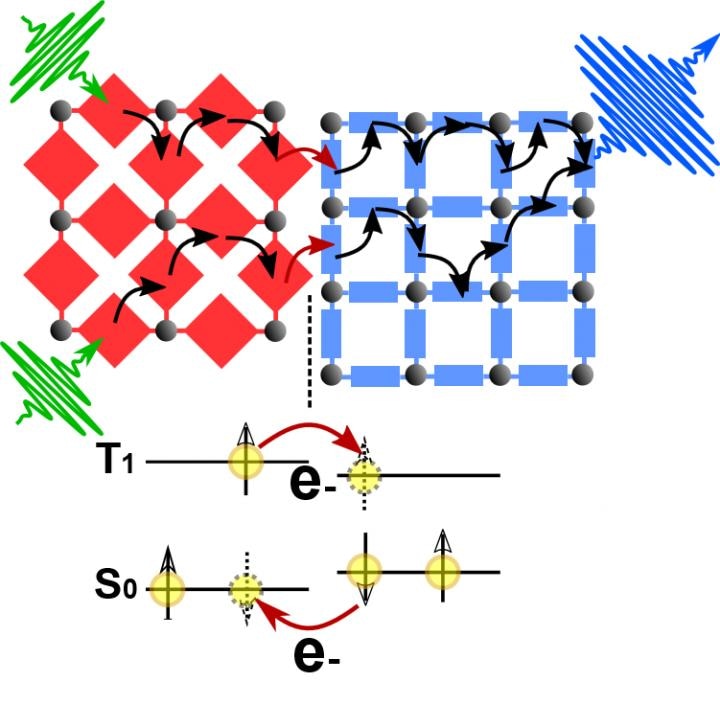Aug 11 2016
 Photon upconversion: energy transfer between the molecules is based on electron exchange (Dexter electron transfer). (CREDIT - Michael Oldenburg)
Photon upconversion: energy transfer between the molecules is based on electron exchange (Dexter electron transfer). (CREDIT - Michael Oldenburg)
Light can be more efficiently used with the upconversion of photons - two photons are converted into a single photon possessing higher energy.
Recently, a team of researchers from KIT demonstrated that the inner interfaces between surface-mounted metal-organic frameworks (SURMOFs) are well-suited for this task - they could transform green light blue for the first time. The research findings will be published in the Advanced Materials journal, and pave the way for new avenues in optoelectronic applications such as LEDs or solar cells.
Metal-organic frameworks (MOFs) are highly structured molecular systems that are made up of organic ligands and metallic clusters. At the Institute of Functional Interfaces (IFG) of KIT, the team created MOFs capable of growing epitaxially on the surfaces of substrates.
It is possible to produce these SURMOFs using many types of materials. They can also be tailored using varied pore sizes and chemical functionalities so that they are well-matched for a wide range of applications, e.g. for catalysts, sensors, diaphragms, as intelligent storage elements, or in medical device technology.
Optoelectronics is another field of application where the components are capable of transforming light into electrical energy or vice versa. Several of these components function with the use of semiconductors.
The SURMOFs combine the advantages of organic and anorganic semiconductors. They feature chemical diversity and crystallinity, allowing us to create ordered heterostructures.
Professor Christof Wöll, Director of IFG
In several optoelectronic components, a heterojunction, which is an interfacing layer between two different semiconductor materials, controls the transfer of energy among the numerous excited states. The KIT team currently has developed a new piggyback SURMOF in which another SURMOF grew epitaxially on a first one. At this heterojunction, photon upconversion could be accomplished, converting two low-energy photons into a single photon possessing higher energy, by fusing them together.
“This process turns green light blue. Blue light has a shorter wavelength and yields more energy. This is very important for photovoltaics applications,” explains Professor Bryce Richards, Director of IMT.
The photon upconversion method developed by the Karlsruhe researchers is based on the triplet-triplet annihilation. Here two molecules are involved - a sensitizer molecule that absorbs photons and produces triplet excited states, and an emitter molecule that controls the triplet excited states and, by using triplet-triplet annihilation, transmits a photon that generates a higher energy than the photons that were absorbed at first.
The challenge was to create this process as efficiently as possible. We matched the sensitizer and emitter layers in a way to obtain a low conversion threshold and a higher light efficiency at the same time.
Dr. Ian Howard, IMT
The triplet transfer is due to the exchange of electrons, so the photon upconversion method demonstrated by the team includes an electron transfer over the interface between the two SURMOFs. This indicates the hypothesis that SURMOF-SURMOF heterojunctions are appropriate for several optoelectronic applications such as solar cells and LEDs.
One of the constraints relating to the efficiency of currently available solar cells is due to the fact that they can only apply photons with a specific minimum energy for electric power generation. Photovoltaic systems that use upconversion can thereby become very efficient.